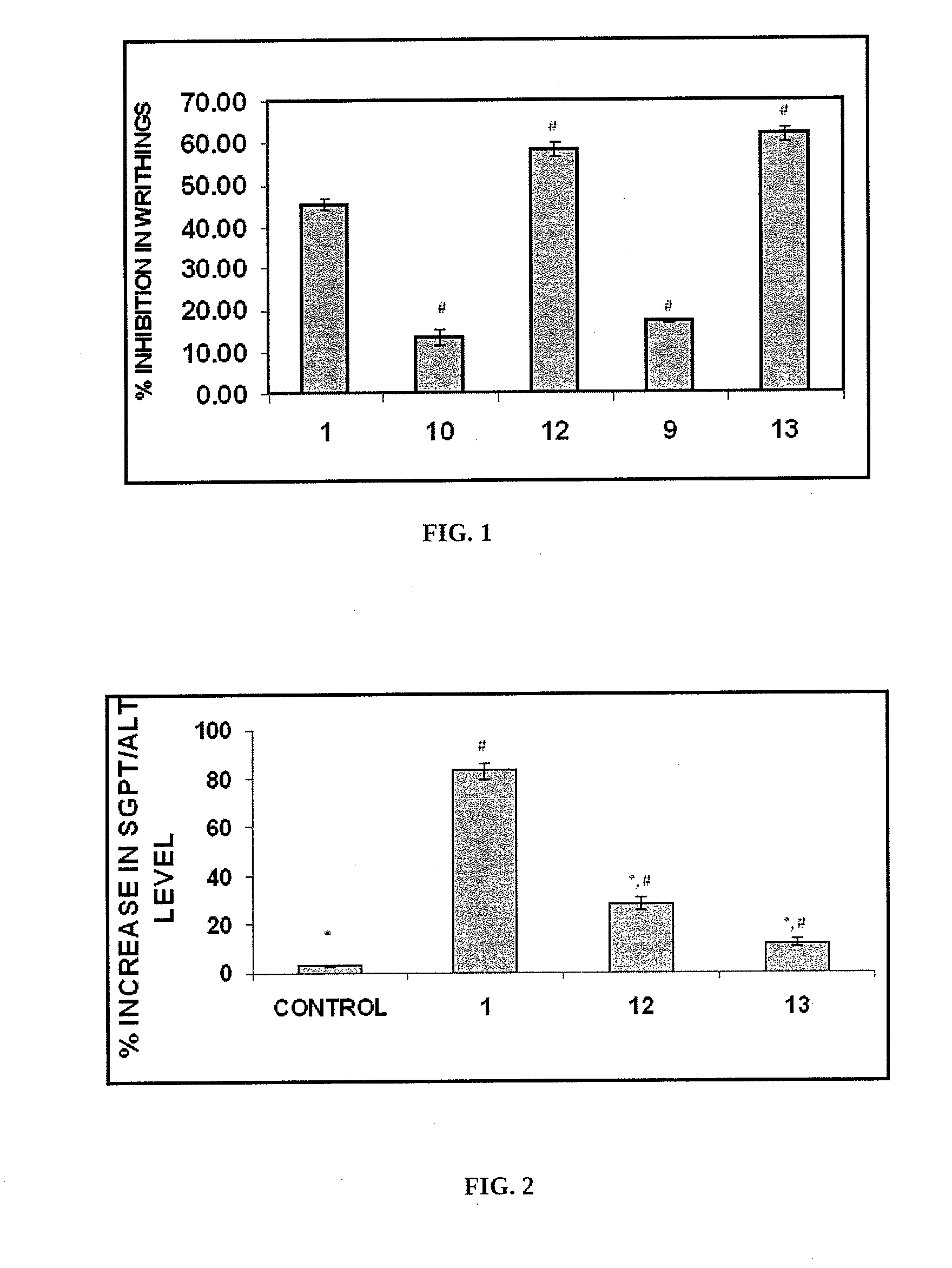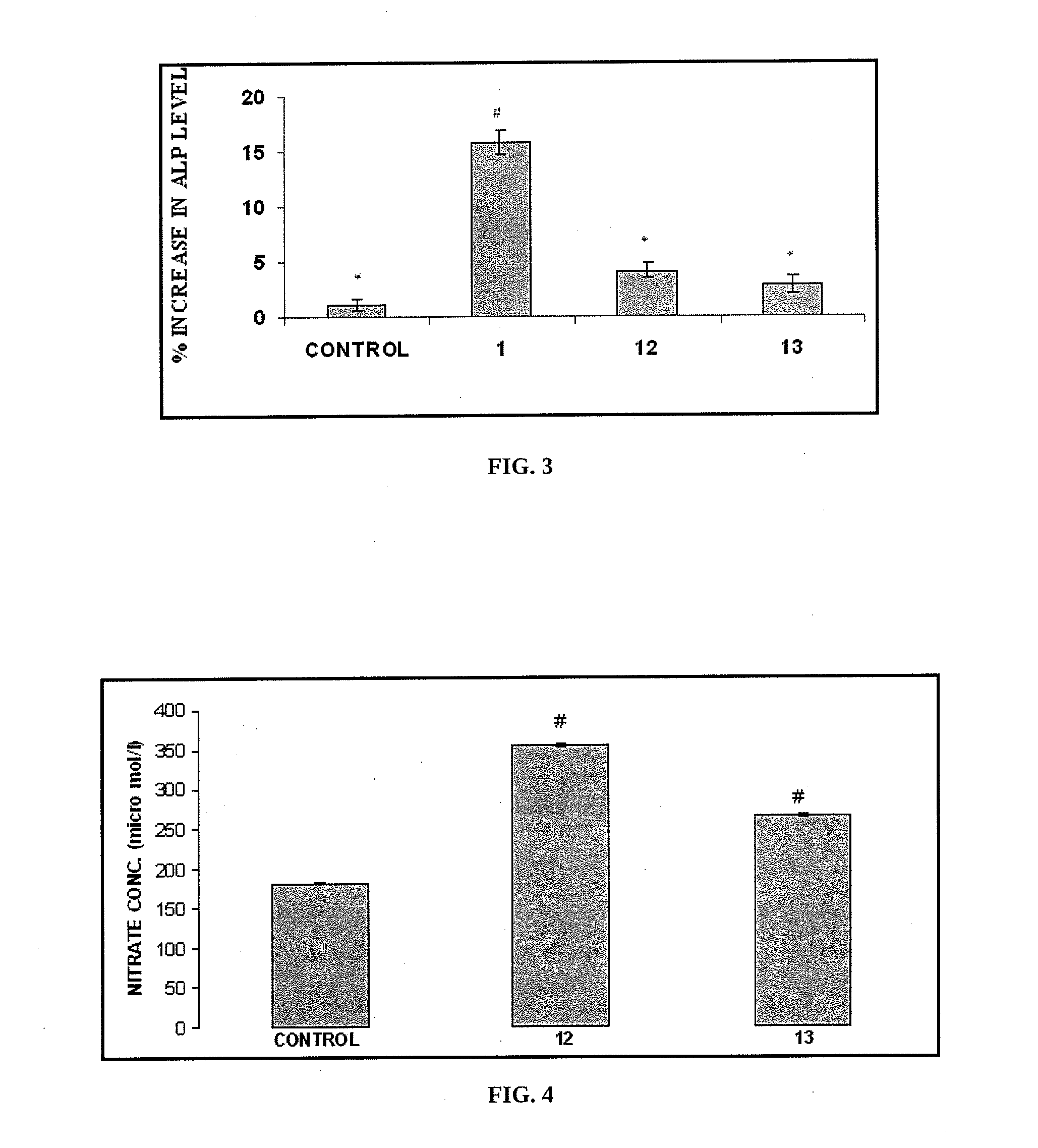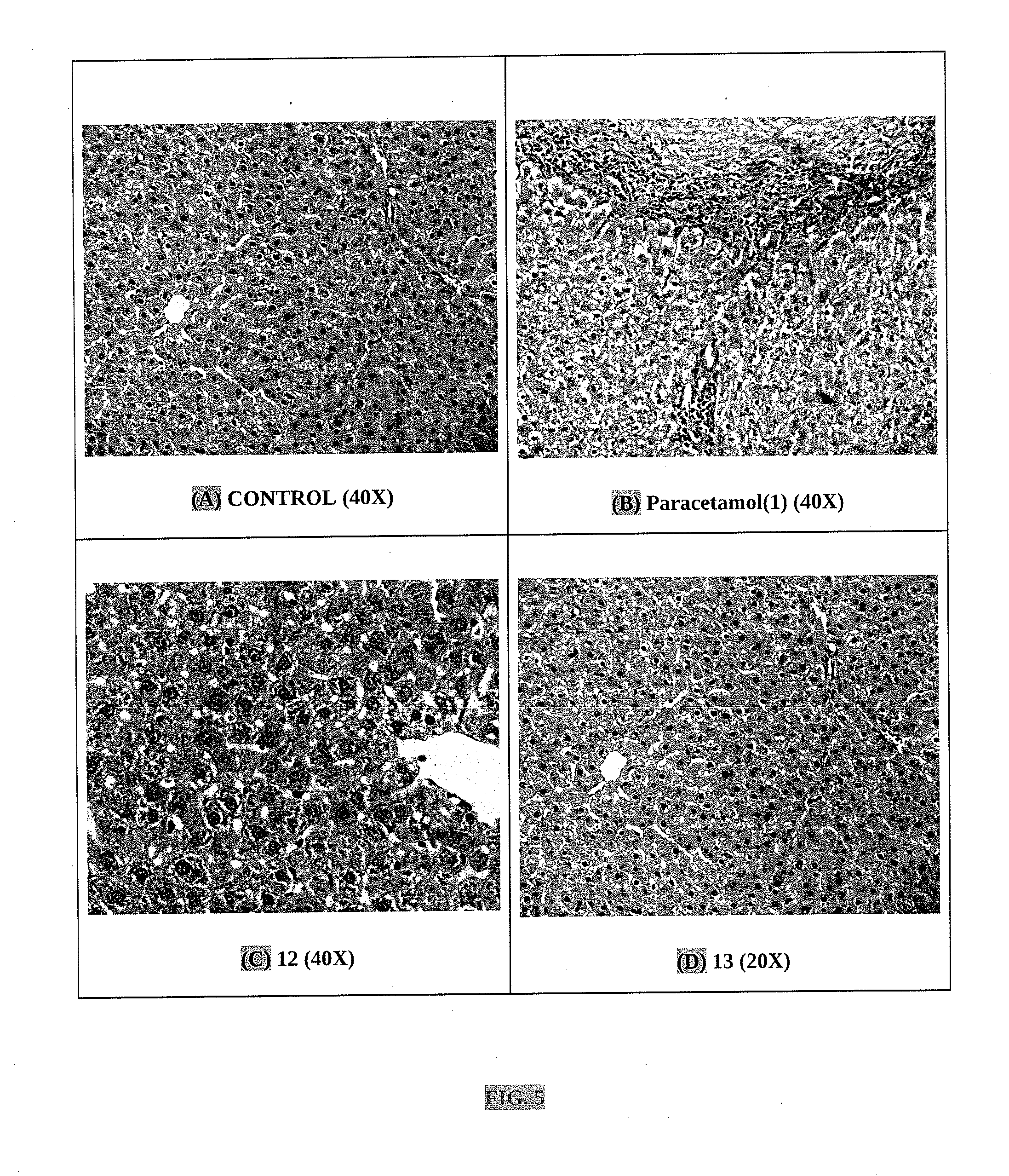Nitric oxide releasing derivatives of paracetamol
a technology of nitric oxide and paracetamol, which is applied in the direction of biocide, amide active ingredients, drug compositions, etc., can solve the problems of liver toxicity and achieve the effect of less liver toxicity and better activity
- Summary
- Abstract
- Description
- Claims
- Application Information
AI Technical Summary
Benefits of technology
Problems solved by technology
Method used
Image
Examples
example 1
N-[4-(2-Bromo-ethoxy)-phenyl]-acetamide (10)
[0067]A solution of N-(4-hydroxyphenyl)-acetamide (paracetamol) (1) (1.50 g, 0.01 mol) and 1,2-dibromoethane (8) (10.0 ml) in ethyl methyl ketone (25.0 ml) containing potassium carbonate (5.0 g) was stirred for 8 hr at room temperature. The reaction mixture was filtered, residue washed with ethyl methyl ketone and solvent evaporated under reduced pressure to get the residue. The residue was dissolved in chloroform (200.0 ml), washed with 5% NaOH solution (3×100 ml), water (3×50 ml), dried, filtered and crystallized from methanol to get the desired product N-[4-(2-bromo-ethoxy)-phenyl]-acetamide (10) (2.01 g, 78.51%), mp 126-127° C.
[0068]Analysis:
[0069]IR (KBr): 3302, 3024, 1662, 1551, 1242, 1029 and 828 cm−1
[0070]1H NMR (CDCl3): δ 2.10 (s, 3H, —NHCOCH3), 3.65 (t, 2H, J=5.9 Hz, CH2Br), 4.26 (t, 2H, J=5.9 Hz, —OCH2), 6.83 (d, 2H, Ar—H), 7.49 (d, 2H, Ar—H), 9.42 (s, 1H, —NH, Exchangeable with D2O)
[0071]13C NMR (CDCl3): δ 23.49 (—NHCOCH3), 29...
example 2
N-[4-(5-Bromo-pentoxy)-phenyl]-acetamide (11)
[0079]A solution of N-(4-hydroxyphenyl)-acetamide (paracetamol) (1) (1.50 g, 0.01 mol) and 1,5-dibromopentane (9) (10.0 ml) in ethyl methyl ketone (25.0 ml) containing potassium carbonate (5.0 g) was stirred for 8 hr at room temperature. The reaction mixture was filtered, residue washed with ethyl methyl ketone and solvent evaporated under reduced pressure to get the residue. The residue was dissolved in chloroform (200.0 ml), washed with 5% sodium hydroxide solution (3×100 ml), water (3×50 ml), dried, filtered and crystallized from methanol to get the desired product N-[4-(5-bromo-pentoxy)-phenyl]-acetamide (11) (2.15 g, 72.15%), mp 110-111° C.
[0080]Anal.
[0081]IR (KBr): 3303, 3031, 2944, 1660, 1549, 1410, 1239, 1045 and 735 cm−1
[0082]1H NMR (CDCl3): δ 1.62 (m, 2H, —CH2CH2CH2—), 1.81 (p, 2H, J=7.4 Hz, —OCH2CH2—), 1.92 (m, 2H, —CH2CH2Br—), 2.11 (s, 3H, —NHCOCH3), 3.43 (t, 2H, J=6.3 Hz, —CH2Br), 3.92 (t, 2H, J=6.3 Hz, —OCH2—), 6.81 (d, 2H,...
example 3
N-[4-(3-Bromo-propoxy)-phenyl]-acetamide (16)
[0093]A solution of N-(4-hydroxyphenyl)acetamide (paracetamol) (1) (1.50 g) and 1,3-dibromobutane (14) (10.0 ml) in ethyl methyl ketone (25.0 ml) containing potassium carbonate (5.0 g) was stirred overnight at room temperature. The reaction mixture was filtered, residue washed with ethyl methyl ketone and solvent evaporated under reduced pressure to get the residue. The residue was dissolved in chloroform (200.0 ml), washed with 5% NaOH solution (3×100 ml), water (3×50 ml), dried, filtered and crystallized from methanol to get the desired product N-[4-(3-Bromo-propoxy)-phenyl]-acetamide (16) (2.01 g, 75.8%), mp 115-118° C.
[0094]Analysis:
[0095]IR (KBr): 3284, 1658, 1559, 1410, 1239, 1032, 832 and 521 cm−1
[0096]1H NMR (400 MHz, CDCl3): δ 2.14 (s, 3H, —NHCOCH3), δ 2.30 (p, 2H, J=6.1, —CH2CH2Br—), δ 3.59 (t, 2H, J=6.4 Hz, —CH2Br), δ 4.07 (t, 2H, J=5.8 Hz, —OCH2—): δ 6.86 (d, 2H, J=3.0 Hz, Ar—H), δ 7.37 (d, 2H, J=3.0 Hz, Ar—H) and δ 7.27 (s, ...
PUM
| Property | Measurement | Unit |
|---|---|---|
| pH | aaaaa | aaaaa |
| pH | aaaaa | aaaaa |
| volume | aaaaa | aaaaa |
Abstract
Description
Claims
Application Information
 Login to View More
Login to View More - R&D
- Intellectual Property
- Life Sciences
- Materials
- Tech Scout
- Unparalleled Data Quality
- Higher Quality Content
- 60% Fewer Hallucinations
Browse by: Latest US Patents, China's latest patents, Technical Efficacy Thesaurus, Application Domain, Technology Topic, Popular Technical Reports.
© 2025 PatSnap. All rights reserved.Legal|Privacy policy|Modern Slavery Act Transparency Statement|Sitemap|About US| Contact US: help@patsnap.com



